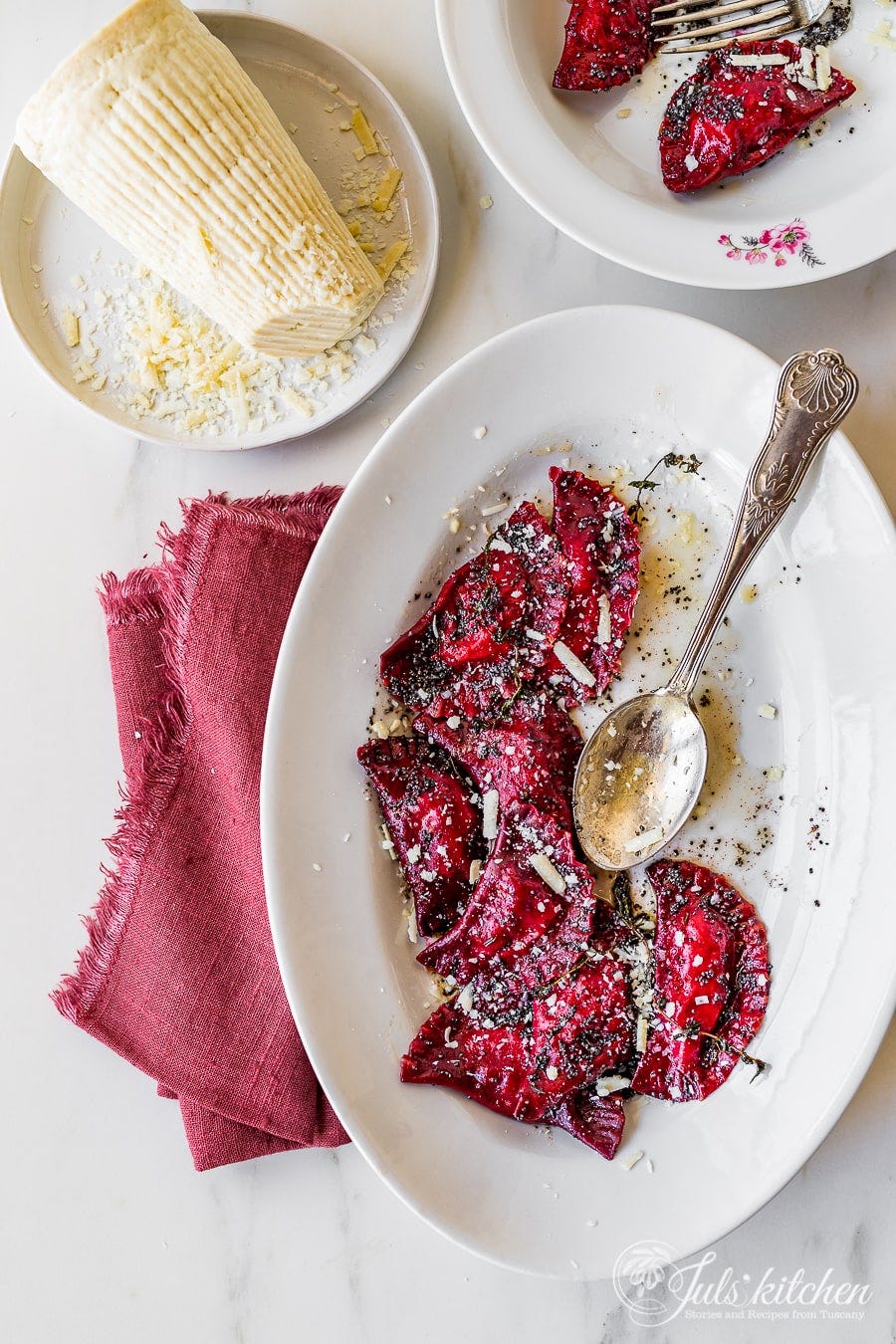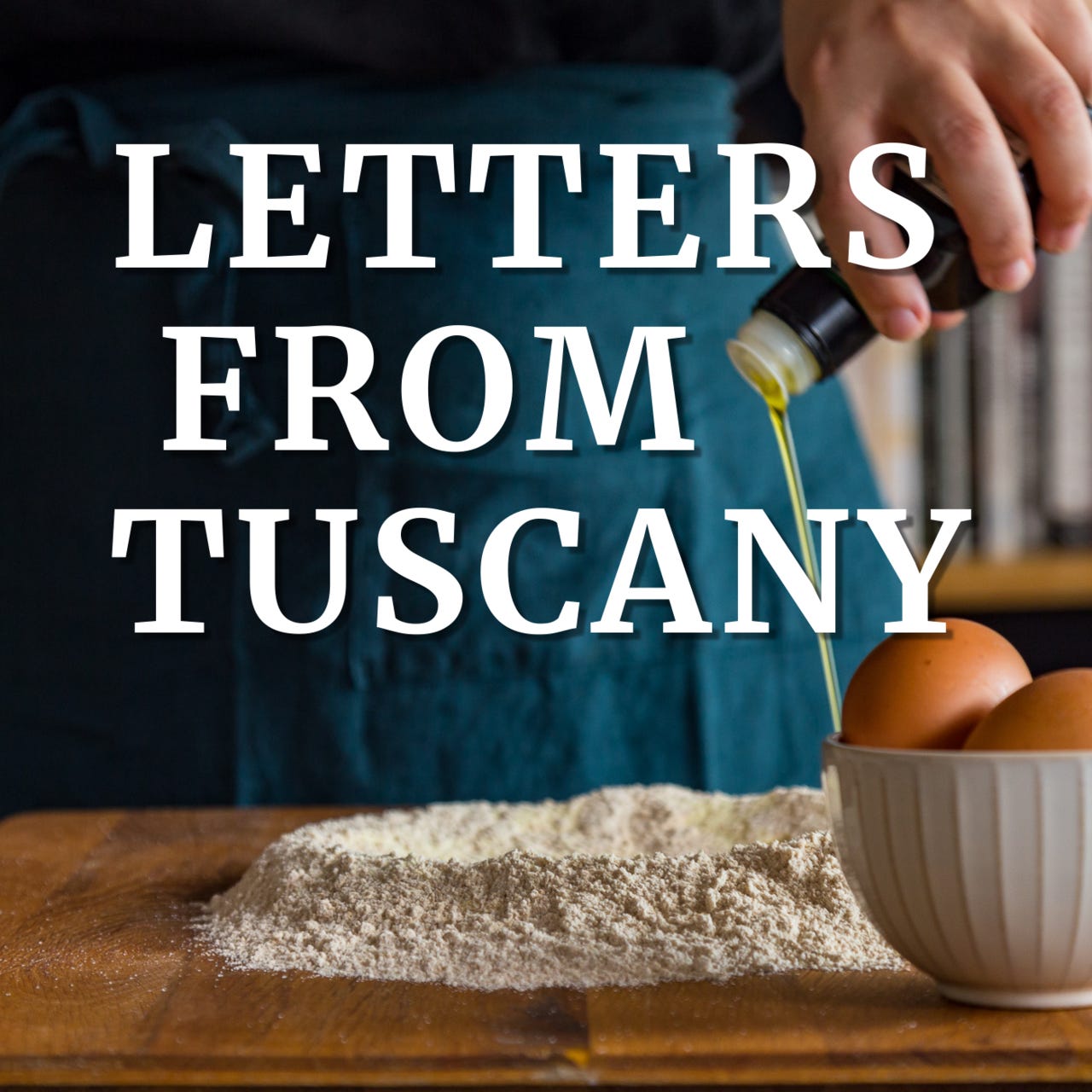Growing up, beets in my house were bought rarely, always pre-cooked and sealed in plastic. The only way my dad would eat them was thickly sliced and slathered in mayonnaise, something I still love from time to time.
The first time I was introduced to raw beetroots was at the local farmers’ market, more than 10 years ago. At that time, I was teaching cooking classes for children at the market: we would go from stall to stall, picking what was fresh and seasonal, to assemble all the ingredients afterwards into bruschetta, vegetable spreads or fresh pasta parcels.
One Sunday morning, right on the verge between winter and spring, there was one German guy, chef and owner of a deli shop, who was panfrying in olive oil thin slices of beetroots, previously dredged in flour. He sprinkled the beets with salt and passed me one to try: that was love at first bite and the moment when my relationship with fresh beets changed.
Purple beetroot ravioli with ricotta, walnuts, and thyme. Where the idea was born
Last year, during some research for the cookbook, I encountered the casunziei from Cortina d’Ampezzo, in the Alps, the cutest fresh pasta parcels stuffed with beets and potatoes, drizzled with poppy seed butter and showered with aged, smoked ricotta.
Today’s stuffed pasta was born from the union of my beetroot carpaccio and casunziei ampezzani.
The beetroot, though, goes into the pasta dough, turning it into bright purple silken pasta sheets. The filling is made with chopped toasted walnuts, ricotta, grated pecorino, and fresh thyme for earthiness. Finally, I dressed the ravioli just like I would do with casunziei, with butter, poppy seeds, and aged ricotta.
You can get the recipe along with more details on how to make such a show-stopping purple fresh pasta on the blog today. Go check it!
If you decide to participate in the weekend cooking project, share the results with us on social media by using the hashtag #myseasonaltable and tagging @julskitchen on Instagram.
If you have questions about the ingredients or the recipe, if you have a special request for one of the following cooking projects, or want to have a chat, reply to this email or leave a comment.
Bonus recipe. Quattro Formaggi sauce
I tossed the ravioli in a simple poppy seed butter dressing, but a rich Quattro formaggi sauce would be equally delicious.
Quattro formaggi is the Italian equivalent of a cheese sauce, so choose the cheese you have at hand. Here I used fontina and taleggio, but feel free to opt for gruyere or cheddar, too. As for gorgonzola, your favourite blue cheese would do, too.
Ingredients
2 cups/250 ml heavy cream
1 garlic clove
6 sage leaves
3 ounces/85 grams rind-free Taleggio, cut into roughly 1-inch chunks
3 ounces/85 grams rind-free Fontina, coarsely grated
3 ounces/85 grams grated Parmigiano Reggiano
3 ounces/85 grams gorgonzola dolce, cut into roughly 1-inch chunks
Freshly ground black pepper
Heat the cream with the garlic and the sage leaves in a large pan over medium heat until simmering. Remove from the heat and discard the garlic and the sage leaves.
Add the taleggio, fontina, and grated Parmigiano and stir until all the cheese has melted and the sauce is creamy and smooth. Set aside.
When you’re ready to cook the ravioli, reheat the cheese sauce if it has cooled down and loosen it with some of the ravioli cooking water.
Any leftover sauce can be kept in the fridge for up to 3 days and gently reheated before using.
The new Substack App!
I have exciting news to share: You can now read Letters from Tuscany in the new Substack app for iPhone.
I have been waiting for this feature since I started reading many newsletters: I wanted an app where I could easily read all my favourite food writers, and now, there it is!
With the app, you’ll have a dedicated Inbox for my Substack and any others you subscribe to. New posts will never get lost in your email filters, or stuck in spam. Longer posts will never cut-off by your email app. Comments and rich media will all work seamlessly. Overall, it’s a big upgrade to the reading experience.
The Substack app is currently available for iOS. If you don’t have an Apple device, you can join the Android waitlist here.
Support us by joining our paid newsletter
[If you already subscribed to our newsletter, thank you!]
When you join our subscription-based newsletter, you are actively contributing to the making of Letters from Tuscany, granting us the time, energy, and resources to research, test and re-test, and photograph the recipes, to write the stories and the interviews, to film the videos that we share here. You are part of the reason why we keep cooking, writing, and sharing, so thank you.
Letters from Tuscany is your anchor to Italy, to the Italian table and our loud conviviality, a reason to experiment with lesser-known ingredients, the voice of a friend in the kitchen.
What you missed recently: Florentine rice fritters, Pasta alla puttanesca, Ciaccino with ham and mozzarella, Leek and potato soup, Pittule salentine.
Whenever you decide to join us, you will have complete access to the whole archive of already published recipes and stories.
Workshops for Ukraine
How can a recipe actively support the hundreds of thousands of refugees who had to leave their homes and land because of the devastating war in Ukraine?
With The Bluebird Kitchen, Frollemente, Claudiu Frasiloaia, Momacys, To be bread, Mangioquindisono, Healthylittlecravings, and Fancyfactory we created Workshops for Ukraine, a fundraiser in which we offer our time and knowledge to help the Red Cross that in these days is trying to support hundreds of thousands of refugees.
You can decide to donate a free amount or participate in one of the courses we have created for you (they are all in Italian).
But back to the recipe. How can a recipe have such disruptive power?
In the workshop I’ll be teaching, How to Write a Recipe, we’ll see how recipes are chemical formulas that rely on the perfect balance of ingredients and process, and consequently require precise language and a shared code. On the other hand, though, recipes are also a concentration of culture, traditions, customs, and values, which transmit a world of flavours and tastes, keep it alive and also mark its evolution.
In this two-hour workshop, we’ll look at recipe writing from these two different perspectives. We’ll also talk about the tone of voice, how recipe writing has evolved over time (from Eliza Acton to Julia Child to Nigella Lawson), the difference between writing a recipe for a blog or a cookbook, the conversion from grams to cups, which is not only a matter of numbers but also of different cultural worlds.
Join us, make a donation, or simply share this initiative: every little gesture counts!









I love beets in a vinaigrette! I am also loving the Substack app. Newsletters have been a God-send to me during the pandemic, but I find it so hard to read them on my phone, and also to read blog posts on my phone, and I am rarely on a computer. This app makes it so much easier!!!
We make salad calls in Ukraine “vinigret “boiled beetroot,potato,carrot,pickled cucumber diced in 6-8mm cubes ,canned pee drizzled with olive oil salt,pepper